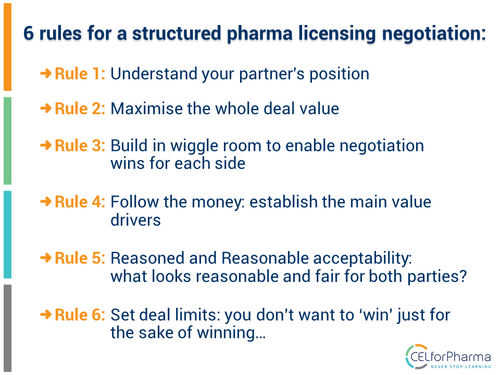To successfully navigate the intricacies of pharmaceutical licensing negotiations, you need a strategic and principled approach.
According to Dr Roger Cox, CELforPharma faculty member of The Pharma Licensing Negotiation Course, the following six fundamental rules will ensure you achieve a fair and mutually valuable deal as a basis for the further collaboration.

Rule 1: Understand Your Partner's Position
Before diving into negotiations, it is important you know where the other side is coming from. Understand what their position, goals, and limitations are. This way you will get an idea of what your partner can and cannot agree on, allowing you to craft proposals that will resonate with the other side's objectives.
Rule 2: Maximise the Whole Deal Value
Instead of just thinking about one part of the deal, think about the overall value generated by the partnership. Try to make the partnership as valuable as possible for both sides. Look for synergies and collaborative opportunities. By optimising the collective benefit, both parties stand to gain more from the partnership than they would from isolated gains.
Rule 3: Build in Wiggle Room for Negotiation Wins
Don’t start with your final offer or ask for things that are impossible. Chances are close to none that your first offer will be accepted so you need to build in margin for negotiation. Also, be open to changes during the negotiation and consider different options to realise a successful agreement.
Rule 4: Follow the Money: Establish the Main Value Drivers
In any negotiation, financial considerations are often the focus. Identifying and understanding the core value drivers for both sides sets the groundwork for constructive discussions. Is it revenue sharing, royalties, upfront payments, or milestone achievements that hold the most weight? Understanding these preferences helps negotiators create proposals that match the ultimate goals of both parties.
Rule 5: Reasoned and Reasonable Acceptability
Negotiations work best when everyone is being fair. Both parties should be able to look at the agreement and find terms that seem fair and justifiable. As a negotiator, you need to think about what an outsider would perceive as acceptable. A partnership that's based on fair terms is more likely to withstand the tests of time and changing circumstances.
Rule 6: Set Deal Limits
While the pursuit of 'winning' might be alluring, the sixth rule cautions against tunnel vision. Setting limits ensures that negotiators don't get caught up in achieving victories at any cost. It encourages negotiators to prioritise the long-term health of the partnership over short-term wins. The focus is on striking a balance between ambition and prudence.
By following these six rules—knowing the partner, getting the best value for the deal, being flexible, finding what adds value, being fair, and setting boundaries—negotiators can make partnerships that last a long time.
